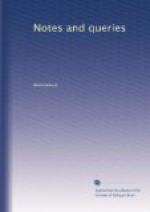“To your professed bosoms I commit him.”
King Lear, Act i. Sc. 1. {140}
“I met the youthful lord at Laurence’
cell,
And gave him what becomed love
I might.
Not stepping o’er the bounds of
modesty.”
Romeo and Juliet, Act iv. Sc. 3.
“Thus ornament is but the guiled
shore
To a most dangerous sea.”
Merchant of Venice, Act iii. Sc. 2.
“Then, in despite of brooded
watchful day,
I would into thy bosom pour my thoughts.”
King John, Act iii. Sc. 3.
“And careful hours, with time’s
deformed hand,
Have written strange defeatures in my
face.”
Comedy of Errors, Act v. Sc. 1.
In all these passages, as well as in that in Measure for Measure, the simple remark, that the poet employed a common grammatical variation, is all that is required for a complete explanation.
J.O. HALLIWELL.
* * * * *
REPLIES TO MINOR QUERIES.
Execution of Charles I.—Sir T. Herbert’s “Memoir of Charles I.” (Vol. ii. pp., 72. 110.).—Is P.S.W.E. aware that Mr. Hunter gives a tradition, in his History of Hallamshire, that a certain William Walker, who died in 1700, and to whose memory there was an inscribed brass plate in the parish church of Sheffield, was the executioner of Charles I.? The man obtained this reputation from having retired from political life at the Restoration, to his native village, Darnall, near Sheffield, where he is said to have made death-bed disclosures, avowing that he beheaded the King. The tradition has been supported, perhaps suggested, by the name of Walker having occurred during the trials of some of the regicides, as that of the real executioner.
Can any one tell me whether a narrative of the last days of Charles I., and of his conduct on the scaffold, by Sir Thomas Herbert, has ever been published in full? It is often quoted and referred to (see “NOTES AND QUERIES,” Vol. i., p. 436.), but the owner of the MS., with whom I am well acquainted, informs me that it has never been submitted to publication, but that some extracts have been secretly obtained. In what book are these printed? The same house which contains Herbert’s MS. (a former owner of it married Herbert’s widow), holds also the stool on which King Charles knelt at his execution, the shirt in which he slept the night before, and other precious relics of the same unfortunate personage.




